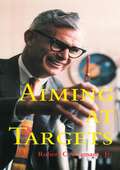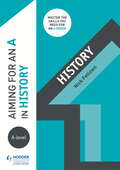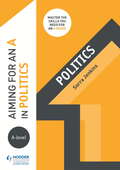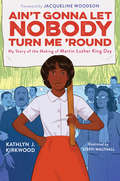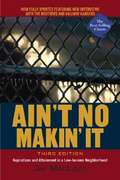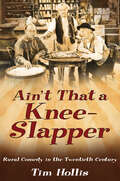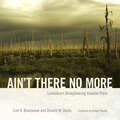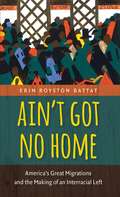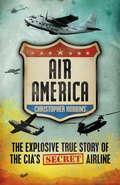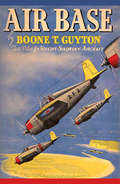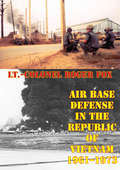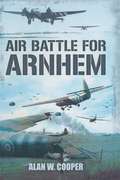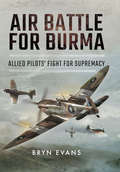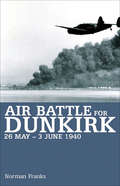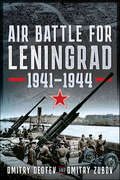- Table View
- List View
Aimee & Jaguar: A Love Story, Berlin 1943
by Edna Mccown Erica FischerA real-life love story between two women, one of them a Jew living illegally on the streets during WWII.
Aimee & Jaguar: A Love Story, Berlin 1943
by Erica FischerThis powerful, poignant, and inspirational novel, a Lambda Literary Award winner, is the true story of two unlikely lovers set against World War II Berlin—a riveting chronicle of love, loyalty, and survival against all odds.“A memorable, vivid, and intimate portrait.” — Entertainment WeeklyBerlin 1942. Lilly Wust, 29, married, four children, led a life as did millions of German women. But then she met the 21-year-old Felice Schragenheim.It was love almost at first sight. Aimée and Jaguar started forging plans for the future. They composed poems and love letters to each other, and wrote their own marriage contract. When Jaguar-Felice admitted to her lover that she was Jewish, this dangerous secret drew the two women even closer to one another. But their luck didn’t last. On August 21, 1944, Felice was arrested and deported.At the age of 80, Lilly Wust told her story to Erica Fischer, who turned it into a poignant testimony. After the book appeared in 1994 she was contacted by additional contemporaries of Aimée and Jaguar, who offered new material that has been integrated into the present edition.The book, translated into twenty languages, and the film based on it—directed by Max Färberböck, with Juliane Köhler and Maria Schrader in the leading roles—have made Aimée and Jaguar’s story known around the world.
Aimee Semple Mcpherson and the Resurrection of Christian America
by Matthew Avery SuttonDuring the years between the two world wars, Aimee Semple McPherson was the most flamboyant and controversial minister in the United States. She built an enormously successful and innovative megachurch, established a mass media empire, and produced spellbinding theatrical sermons that rivaled Tinseltown's spectacular shows. As McPherson's power grew, she moved beyond religion into the realm of politics, launching a national crusade to fight the teaching of evolution in the schools, defend Prohibition, and resurrect what she believed was the United States' Christian heritage. Convinced that the antichrist was working to destroy the nation's Protestant foundations, she and her allies saw themselves as a besieged minority called by God to join the "old time religion" to American patriotism. Matthew Sutton's definitive study of Aimee Semple McPherson reveals the woman, most often remembered as the hypocritical vamp in Sinclair Lewis's Elmer Gantry, as a trail-blazing pioneer. Her life marked the beginning of Pentecostalism's advance from the margins of Protestantism to the mainstream of American culture. Indeed, from her location in Hollywood, McPherson's integration of politics with faith set precedents for the religious right, while her celebrity status, use of spectacle, and mass media savvy came to define modern evangelicalism.
Aimer mon méchant voleur
by Dawn BrowerLady Francesca Kendall, fille du marquis de Blackthorn, est emportée par le scandaleux duc de Lindsey lors de leur première rencontre. Ce qui aurait pu être une aventure d'un soir finit par s'épanouir en quelque chose de beau, mais non sans malentendus et désaccords au début. Leur relation n'avait pas été conventionnelle mais pas regrettable non plus. Francesca serait toujours reconnaissante d'aimer son méchant voyou.
Aimez Seulement Moi
by Amanda MarielLa passion rassemble les deux alors qu’ils découvrent que l’amour est plus important que les obligations et les loyautés qui menacent de les séparer. Née comme une femme noble, élevée infernale, Madame Narissa se déplace avec aisance entre l'élite Londonienne et ses occupants les plus pauvres. N'ayant jamais accepté son rôle de fille de comte, elle a créé un enfer de jeu secret réservé aux femmes et destiné aux dames du beau monde. Elle est déterminée à protéger son héritage à tout prix. Seth Blakley, duc de Blackmore, a les mains pleines avec sa sœur fougueuse. Son seul désir est de la voir se marier correctement avant qu'elle ne se ruine irrévocablement. Il n'aurait jamais pu imaginer ce qui l'attendait en la suivant dans l'enfer du jeu de Madame Narissa. Seth est captivé par Madame Narissa et déterminé à en apprendre davantage sur la beauté entêtée et non conventionnelle. Peu importe que tout ce qu’elle souhaite, ce soit qu’il soit parti et que son souvenir de son club soit oublié. La passion rassemble les deux alors qu’ils découvrent que l’amour est plus important que les obligations et les loyautés qui menacent de les séparer.
Aiming at Targets: The Autobiography of Robert C. Seamans Jr.
by Roger C. Seamans Jr.An essential volume in the NASA History Series by Robert C. Seamans, Jr., the Associate Administrator of NASA during the Apollo program. A stirring insider’s account of NASA and the manned space program at the highest levels. Relationships with the Department of Defense, the Apollo 204 fire, the assassination of President Kennedy, and more.Aiming at Targets is a series of fascinating topical vignettes covering the author’s professional life. Taken together, like broad brushstrokes in an impressionist painting, they give a better picture of Bob Seamans and his work than a detailed recitation of facts and dates could hope to do. This is a cheerful account of an interesting and successful career. The book is full of good stories, with many memorable characters. Like the proverbial sundial, it counts the sunny hours.
Aiming for an A in A-level History
by Nicholas FellowsExam board: AQA, Edexcel, OCR, WJECLevel: A-levelSubject: HistoryFirst teaching: September 2015First exams: Summer 2017Master the skills you need to set yourself apart and hit the highest grades. This year-round course companion develops the higher-order thinking skills that top-achieving students possess, providing step-by-step guidance, examples and tips for getting an A grade.Written by experienced author and teacher Nicholas Fellows, Aiming for an A in A-level History:- Develops the 'A grade skills' of analysis, evaluation, creation and application, ensuring that students know how to apply these skills and approach each exam question as an A/A* candidate- Takes students step by step through specific skills they need to master in A-level History, including historical reading, investigative skills, short-essay writing and long-essay writing- Clearly shows how to move up the grades with sample responses that have been annotated to highlight the key features of A/A* answers- Puts the theory behind achieving an A grade into practice, providing in-class or homework activities and further reading tasks that stretch towards university-level study- Perfects exam technique through practical tips and examples of common pitfalls to avoid- Cultivates effective revision habits for success, with tips and strategies for producing and using revision resources- Supports major exam boards, outlining the Assessment Objectives for reaching the higher levels under the AQA, Edexcel, OCR and WJEC specifications
Aiming for an A in A-level History
by Nicholas FellowsExam board: AQA, Edexcel, OCR, WJECLevel: A-levelSubject: HistoryFirst teaching: September 2015First exams: Summer 2017Master the skills you need to set yourself apart and hit the highest grades. This year-round course companion develops the higher-order thinking skills that top-achieving students possess, providing step-by-step guidance, examples and tips for getting an A grade.Written by experienced author and teacher Nicholas Fellows, Aiming for an A in A-level History:- Develops the 'A grade skills' of analysis, evaluation, creation and application, ensuring that students know how to apply these skills and approach each exam question as an A/A* candidate- Takes students step by step through specific skills they need to master in A-level History, including historical reading, investigative skills, short-essay writing and long-essay writing- Clearly shows how to move up the grades with sample responses that have been annotated to highlight the key features of A/A* answers- Puts the theory behind achieving an A grade into practice, providing in-class or homework activities and further reading tasks that stretch towards university-level study- Perfects exam technique through practical tips and examples of common pitfalls to avoid- Cultivates effective revision habits for success, with tips and strategies for producing and using revision resources- Supports major exam boards, outlining the Assessment Objectives for reaching the higher levels under the AQA, Edexcel, OCR and WJEC specifications
Aiming for an A in A-level Politics
by Sarra JenkinsExam Board: AQA, Edexcel, WJEC/Eduqas Level: A-level Subject: Politics First teaching: September 2017 First exams: Summer 2019 Master the skills you need to set yourself apart and hit the highest grades; this year-round course companion develops the higher-order thinking skills that top-achieving students possess, providing step-by-step guidance, examples and tips for getting an A grade.Written by experienced author and teacher Sarra Jenkins, Aiming for an A in A-level Politics:Helps you develop the 'A grade skills' of analysis, evaluation, creation and applicationTakes you step by step through specific skills you need to master in A-level Politics, so you can apply these skills and approach each exam question as an A/A* candidateClearly shows how to move up the grades with sample responses annotated to highlight the key features of A/A* answersHelps you practise to achieve the levels expected of top-performing students, using in-class or homework activities and further reading tasks that stretch towards university-level studyPerfects exam technique through practical tips and examples of common pitfalls to avoid Cultivates effective revision habits for success, with tips and strategies for producing and using revision resourcesSupports the major exam boards, outlining the Assessment Objectives for reaching the higher levels under the AQA, Edexcel and WJEC/Eduqas specifications.
Aiming for an A in A-level Politics
by Sarra JenkinsExam Board: AQA, Edexcel, WJEC/Eduqas Level: A-level Subject: Politics First teaching: September 2017 First exams: Summer 2019 Master the skills you need to set yourself apart and hit the highest grades; this year-round course companion develops the higher-order thinking skills that top-achieving students possess, providing step-by-step guidance, examples and tips for getting an A grade.Written by experienced author and teacher Sarra Jenkins, Aiming for an A in A-level Politics:Helps you develop the 'A grade skills' of analysis, evaluation, creation and applicationTakes you step by step through specific skills you need to master in A-level Politics, so you can apply these skills and approach each exam question as an A/A* candidateClearly shows how to move up the grades with sample responses annotated to highlight the key features of A/A* answersHelps you practise to achieve the levels expected of top-performing students, using in-class or homework activities and further reading tasks that stretch towards university-level studyPerfects exam technique through practical tips and examples of common pitfalls to avoid Cultivates effective revision habits for success, with tips and strategies for producing and using revision resourcesSupports the major exam boards, outlining the Assessment Objectives for reaching the higher levels under the AQA, Edexcel and WJEC/Eduqas specifications.
Ain't Gonna Let Nobody Turn Me 'Round: My Story of the Making of Martin Luther King Day
by Kathlyn J. KirkwoodThis brilliant memoir-in-verse tells the moving story of how a nation learned to celebrate a hero. Through years of protests and petition, Kathlyn's story highlights the foot soldiers who fought to make Martin Luther King Jr.'s birthday a national holiday.Ain&’t Gonna Let Nobody Turn Me &’Round is a deeply moving middle grade memoir about what it means to be an everyday activist and foot solider for racial justice, as Kathlyn recounts how, drawn to activism from childhood, she went from attending protests as a teenager to fighting for Martin Luther King, Jr.'s birthday to become a national holiday as an adult. A blueprint for kids starting down their own paths to civic awareness, it shows life beyond protests and details the sustained time, passion, and energy it takes to turn an idea into a law. Deftly weaving together monumental historical events with a heartfelt coming-of-age story and in-depth information on law making, Ain&’t Gonna Let Nobody Turn Me &’Round is the perfect engaging example of how history can help inform the present.
Ain't I A Woman? (Penguin Great Ideas)
by Sojourner Truth'I am a woman's rights. I have plowed and reaped and husked and chopped and mowed, and can any man do more than that? I am as strong as any man that is now'A former slave and one of the most powerful orators of her time, Sojourner Truth fought for the equal rights of Black women throughout her life. This selection of her impassioned speeches is accompanied by the words of other inspiring African-American female campaigners from the nineteenth century.One of twenty new books in the bestselling Penguin Great Ideas series. This new selection showcases a diverse list of thinkers who have helped shape our world today, from anarchists to stoics, feminists to prophets, satirists to Zen Buddhists.
Ain't No Makin' It: Aspirations and Attainment in a Low-income Neighborhood
by Jay MacleodThis classic text addresses one of the most important issues in modern social theory and policy: how social inequality is reproduced from one generation to the next.
Ain't That a Knee-Slapper: Rural Comedy in the Twentieth Century
by Tim HollisThere was a time when rural comedians drew most of their humor from tales of farmers' daughters, hogs, hens, and hill country high jinks. Lum and Abner and Ma and Pa Kettle might not have toured happily under the "Redneck" marquee, but they were its precursors.In Ain't That a Knee-Slapper: Rural Comedy in the Twentieth Century, author Tim Hollis traces the evolution of this classic American form of humor in the mass media, beginning with the golden age of radio, when such comedians as Bob Burns, Judy Canova, and Lum and Abner kept listeners laughing. The book then moves into the motion pictures of the 1930s, 1940s, and 1950s, when the established radio stars enjoyed second careers on the silver screen and were joined by live-action renditions of the comic strip characters Li'l Abner and Snuffy Smith, along with the much-loved Ma and Pa Kettle series of films. Hollis explores such rural sitcoms as The Real McCoys in the late 1950s and from the 1960s, The Andy Griffith Show, The Beverly Hillbillies, Green Acres, Hee Haw, and many others. Along the way, readers are taken on side trips into the world of animated cartoons and television commercials that succeeded through a distinctly rural sense of fun.While rural comedy fell out of vogue and networks sacked shows in the early 1970s, the emergence of such hits as The Dukes of Hazzard brought the genre whooping back to the mainstream. Hollis concludes with a brief look at the current state of rural humor, which manifests itself in a more suburban, redneck brand of standup comedy.
Ain't There No More: Louisiana's Disappearing Coastal Plain (America's Third Coast Series)
by Carl A. Brasseaux Donald W. DavisWinner of the 2018 Louisiana Literary Award given by the Louisiana Library AssociationFor centuries, outlanders have openly denigrated Louisiana's coastal wetlands residents and their stubborn refusal to abandon the region's fragile prairies tremblants despite repeated natural and, more recently, man-made disasters. Yet, the cumulative environmental knowledge these wetlands survivors have gained through painful experiences over the course of two centuries holds invaluable keys to the successful adaptation of modern coastal communities throughout the globe. As Hurricane Sandy recently demonstrated, coastal peoples everywhere face rising sea levels, disastrous coastal erosion, and, inevitably, difficult lifestyle choices.Along the Bayou State's coast the most insidious challenges are man-made. Since channelization of the Mississippi River in the wake of the 1927 flood, which diverted sediments and nutrients from the wetlands, coastal Louisiana has lost to erosion, subsidence, and rising sea levels a land mass roughly twice the size of Connecticut. State and national policymakers were unable to reverse this environmental catastrophe until Hurricane Katrina focused a harsh spotlight on the human consequences of eight decades of neglect. Yet, even today, the welfare of Louisiana's coastal plain residents remains, at best, an afterthought in state and national policy discussions.For coastal families, the Gulf water lapping at the doorstep makes this morass by no means a scholarly debate over abstract problems. Ain't There No More renders an easily read history filled with new insights and possibilities. Rare, previously unpublished images documenting a disappearing way of life accompany the narrative. The authors bring nearly a century of combined experience to distilling research and telling this story in a way invaluable to Louisianans, to policymakers, and to all those concerned with rising sea levels and seeking a long-term solution.
Aincourt Series Complete Collection: So Wild A Heart\The Hidden Heart\Secrets of the Heart
by Candace CampThe complete Aincourts trilogy by New York Times bestselling author Candace Camp, collected here! So Wild a HeartDevin Aincourt, Earl of Ravenscar, is content to live out his life in a thoroughly hedonistic manner. Until his mother asks him to make a bold move to restore the family name and fortune: marry a rich American heiress, Miranda, who surprises Dev with plans of her own.The Hidden HeartWith his life in ruins, Richard, Duke of Cleybourne, returns to his country estate to deal with the tragic loss he’s suffered. His plans, however, are interrupted by the arrival of Miss Jessica Maitland, a feisty, flame-haired governess who claims that her charge, Gabriella, is his new ward. When a raging storm strands the guests at the estate, Jessica and Richard find themselves on the trail of a murderer.Secrets of the HeartRachel Aincourt despairs that she has married a cold, loveless, enigmatic man in Michael Trent, Earl of Westhampton. But she’s wrong: behind Michael’s proper demeanor lies a man who thrives on danger intrigue, and Rachel is soon pulled into Michael’s schemes—and into his heart.
Ainda mais Natal (Uma Dama Abandonada #4)
by Christina McKnightUma dama procurando redimir o seu passado… Lady Viola Haversham está determinada a deixar o passado para trás. Para isso, ela planeja dar a maior festa de natal que Foldger’s Hall já viu; provando para todo mundo – inclusive para si mesma – que ela tem mais a oferecer que o sofrimento e a perda que tinha trazido para sua família. Uma mulher forjando um novo caminho para a sua vida... A Sra. Ruby Jakeston está cansada de todo mundo cuidando dela. Ela está pronta para mostrar a todos que pode cuidar de mais coisas além de si mesma e do novo marido; ela também quer tranquilizar a amiga super protetora, e fazer a diabinha da sua irmã sossegar. Uma menina perdida em busca do seu lugar… Lady Ellington está prestes a perder o único lar que já conheceu. A última coisa que deseja é ir a uma grande soirée. Mas, quando a irmã mais velha exige a sua presença em uma festa de Natal, ela está inclinada a comparecer. Tendo apenas um cavalariço como companhia, ela chega à casa cheia de rostos desconhecidos – e nenhum lugar onde se esconder. Um trio de mulheres esperando por três milagres distintos… Ainda mais Natal.
Ain’t Got No Home
by Erin Royston BattatMost scholarship on the mass migrations of African Americans and southern whites during and after the Great Depression treats those migrations as separate phenomena, strictly divided along racial lines. In this engaging interdisciplinary work, Erin Royston Battat argues instead that we should understand these Depression-era migrations as interconnected responses to the capitalist collapse and political upheavals of the early twentieth century. During the 1930s and 1940s, Battat shows, writers and artists of both races created migration stories specifically to bolster the black-white Left alliance. Defying rigid critical categories, Battat considers a wide variety of media, including literary classics by John Steinbeck and Ann Petry, "lost" novels by Sanora Babb and William Attaway, hobo novellas, images of migrant women by Dorothea Lange and Elizabeth Catlett, popular songs, and histories and ethnographies of migrant shipyard workers. This vibrant rereading and recovering of the period's literary and visual culture expands our understanding of the migration narrative by uniting the political and aesthetic goals of the black and white literary Left and illuminating the striking interrelationship between American populism and civil rights.
Air America
by Christopher RobbinsThe incredible inside story of the world's most extraordinary covert operation.Air America - a secret airline run by the CIA - flew missions no one else would touch, from General Claire Cennault's legendary Flying Tigers in WW II to two brutal decades cruising over the bomb-savaged jungles of Southeast Asia. Their pilots dared all and did all - a high-rolling, fast-playing bunch of has-beens and hellraisers whose motto was 'Anything, Anywhere, Anytime'. Whether it was delivering food and weapons or spooks and opium, Air America was the one airline where you didn't need reservations - just a hell of a lot of courage and a willingness to fly to the bitter end.
Air Base
by Boone GuytonAir Base, first published in 1941, by aviator Boone Guyton, is a fascinating look at the U.S. Navy's flying fleet shortly before Pearl Harbor and America's entry into the Second World War. In a style ranging from amusing to tragic and harrowing, Guyton describes his experiences as a Navy flyer. Following a year of flight-training at Pensacola, Guyton is based in San Diego with a carrier squadron aboard the Lexington and Saratoga. He describes the training cruises of the ship, the patrol flights, dive bombers, and war games, providing insight into the prewar Navy air force. Included are 8 pages of photographs. Following his naval service, Boone Guyton (1913-1996) worked as a test pilot in France until 1940. He returned to the U.S. and continued his work as a test pilot for Vought with the F4 Corsair. Following the war, Guyton settled in Connecticut and continued working as an executive for several aviation companies.
Air Base Defense In The Republic Of Vietnam 1961-1973 [Illustrated Edition]
by Lt.-Colonel Roger P. FoxIncludes 78 photos and 16 maps / chartsThis book explores the unique problem of defending air bases during the Vietnam War. It centers on the primary efforts of the United States Air Force and allied air units to defend 10 key air bases within the Republic of Vietnam. Bien Hoa, on 1 November 1964, was the first base to be attacked and until the cease-fire in January 1973, these bases suffered a total of 475 attacks.Although there were initial deficiencies in staff support for base defense in such key areas as intelligence, motor vehicles, weapons procurement and maintenance, communications, and civil engineering, significant improvements had been made by the end of the Air Force's part in the war.The author, Lt. Col. Roger P. Fox, USAF (Ret.), wrote this volume while assigned to the Office of Air Force History. He brings judgments to his research based on his personal experience as a base security officer during the conflict. Thus, early on the morning of 4 December 1966, he rallied Air Force and South Vietnamese security forces to repel an enemy attempt to penetrate Tan Son Nhut Air Base, the center of Air Force operations in South Vietnam. For his gallantry in action on this occasion, he was awarded the Silver Star. This personal experience formed a foundation upon which he developed a keen insight into exploring the entire spectrum of air base defense, and upon which he has built a strong case for testing future plans and operations.
Air Battle for Arnhem
by Alan W. CooperOver sixty years ago a battle took place that, if it had succeeded, could have shortened the Second World war by six months. The operation to take the bridges at Arnhem was given the code name 'Operation Market Garden', Market being the air side of the operation and Garden the subsequent ground operation. The main problem was communications between the ground forces and the re-supply aircraft of the Royal Air Force.Its their efforts and the courage on evident display at Arnhem that the book is based upon. Over a period of seven days troops of the 1st Airborne were taken by the RAF in towed gliders and then in subsequent days showed courage of the highest order to make sure that the ground troops were supplied with ammunition and food to sustain them in their efforts to take the bridges at Arnhem. Their efforts were costly, 309 aircrew and 79 Air Dispatchers were killed and 107 aircraft, which included the men and aircraft who supported the main re-supply armada.One of the re-supply aircraft, flown by F/Lt David Lord DFC, was shot down. Lord was later awarded the Victoria Cross. His courage and dedication are exemplary of the efforts of the men of Transport Command to make sure the men on the ground were re-supplied. The men of the Air Dispatchers, or AD's as they were known, must always be remembered when regarding Arnhem. Their efforts to make sure the supplies were released from the aircraft, and on to the besieged men on the ground, was a vital factor in getting vital supplies to the troops successfully.This is their story, vividly told, and serves a commemorative purpose, memorialising both the events and, most importantly, the men who participated.
Air Battle for Burma: Allied Pilots' Fight for Supremacy
by Bryn EvansAfter a long series of crushing defeats by the apparently unstoppable Japanese air and ground forces, the eventual fight back and victory in Burma was achieved as a result of the exercise of unprecedented combined services cooperation and operations. Crucial to this was the Allies supremacy in the air coupled with their ground/air support strategy.Using veterans firsthand accounts, Air Battle For Burma reveals the decisive nature of Allied air power in inflicting the first major defeat on the Japanese Army in the Second World War. Newly equipped Spitfire fighter squadrons made the crucial difference at the turning point battles of the Admin Box, Imphal and Kohima in 1944. Air superiority allowed Allied air forces to deploy and supply Allied ground troops on the front line and raids deep into enemy territory with relative impunity; revolutionary tactics never before attempted on such a scale.By covering both the strategic and tactical angles, through these previously unpublished personal accounts, this fine book is a fitting and overdue tribute to Allied air forces contribution to victory in Burma.
Air Battle for Dunkirk, 26 May–3 June 1940: 26 May - 3 June 1940
by Norman FranksA gripping account of the Royal Air Force&’s daring exploits during the heroic evacuation of Allied troops from France in World War II. &“Where is the RAF?&” was the oft-quoted question asked by soldiers waiting on the beach at Dunkirk, to where they had retreated following the German blitzkrieg through northern France, and where they were now being pounded by the Luftwaffe. The air forces were there, as Norman Franks proves, detailing the outstanding achievements of the Allied pilots who fought, using outmoded tactics, against enemy pilots who had earlier had easy victories over the Polish, Dutch and Belgian air forces. The RAF&’s achievement reminds us just how close Britain came to disaster in June 1940. &“An absorbing read, which vindicates the RAF.&” —RAF Historical Journal &“Leveraging mission logs and splicing firsthand written accounts, the narrative is both cohesive and seamless. The details are incredibly rich, yet not burdensome.&” —Air & Space Power Journal &“With the recent release of the blockbuster film on the same subject, Franks&’ recounting of the air battle for Dunkirk is timely for those who left the movie theater wanting more . . . Air Battle for Dunkirk is recommended for those who loved the film and wanted more context. This book is especially recommended for those who are interested in aviation history.&” —Nicole Granados, Picture This Post
Air Battle for Leningrad: 1941–1944
by Dmitry Degtev Dmitry ZubovThis book examines the full story of the German and Soviet aerial battles in the Leningrad sector during the siege. The Siege of Leningrad was one of the most brutal battles of the Second World War. The second largest and most populous city in the Soviet Union, Leningrad, now St. Petersburg, was one of the three priority targets of the German invasion, Operation Barbarossa. A total of 333 large military factories were concentrated in Leningrad and, accordingly, 565,000 workers lived there, producing tanks, aircraft, artillery and warships. On 10 July 1941, German tank divisions, having broken through the front south of the city of Pskov, reached the town of Luga. From there, Hitler’s forces had just over 110 miles to go to Leningrad. Meanwhile, the city was feverishly preparing for defense. Stalin’s deputies, Zhdanov and Voroshilov, planned to use the entire combat-ready population of Leningrad for that purpose. Believing that the city would soon be captured by the Germans, Stalin ordered the immediate evacuation of military factories and skilled workers from Leningrad to the East. Before the city was completely blockaded, most of the valuable equipment had been removed. However, the remaining civilian population, including about 400,000 children, were left to their fate. In early September 1941, German divisions supported by the Luftwaffe’s VIII Fliegerkorps, captured the town of Shlisselburg. Leningrad was now cut off from the rest of the Soviet Union. Hitler believed that the city would soon echo to the sound of German jackboots. Leningrad, however, did not give up. In the autumn of 1941, the Wehrmacht did not have enough forces to take the city and for three long years the main means of fighting its defenders were the Luftwaffe and long-range artillery. In September 1941, when the systematic bombing and shelling began, many thousands of families tried to leave Leningrad, but nearly all of the escape routes were cut off. Food supplies in the city sharply decreased. In this book the authors explore the full story of the German and Soviet aerial battles in the Leningrad sector during the siege. There are devastating details of the bombing of the starving population, numerous attempts by the Luftwaffe to destroy the Red Baltic Fleet, and air attacks against the ‘Road of Life’, along which vital food and ammunition were delivered to the city, and combats in the skies over Leningrad and its surroundings. Revealing what was happening in the air and on the ground, as well as in the German and Russian headquarters, the authors explain why, in spite of numerous successes, the Luftwaffe failed to help force the surrender of Leningrad.





